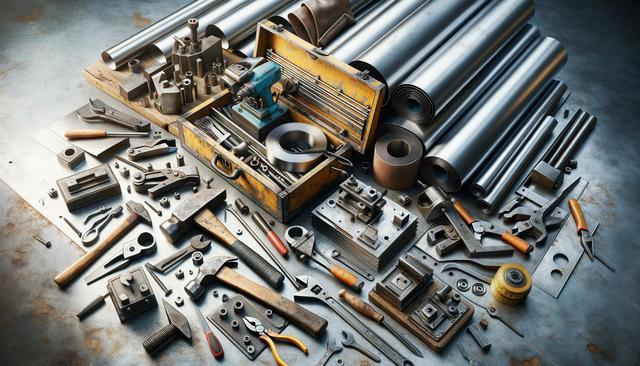Understanding the Role of a Sheet Metal Worker
Sheet metal workers play a crucial role in construction, manufacturing, and maintenance industries. Their work involves fabricating, assembling, installing, and repairing sheet metal products used in a variety of applications, including HVAC systems, roofing, siding, and industrial equipment. This trade requires a mix of technical knowledge, physical ability, and precision. Sheet metal workers often interpret blueprints, operate machinery like shears and press brakes, and use hand tools to create precise components. A strong understanding of safety practices and materials such as aluminum, steel, and copper is also essential.
Many sheet metal professionals specialize in specific areas, such as architectural sheet metal, industrial fabrication, or air-conditioning duct systems. This diversity offers multiple career paths within the field. As the construction and green energy sectors continue to grow, there is increasing demand for skilled workers who can contribute to energy-efficient systems and sustainable building practices.
Key Skills and Tools of the Trade
A successful sheet metal worker needs more than just physical stamina. Technical skills are at the heart of the profession. Workers must be comfortable reading technical drawings and specifications, calculating dimensions, and working with computer-aided design (CAD) software. Precision and attention to detail are paramount, as even small errors can affect the integrity of a finished product.
Essential tools and equipment commonly used by sheet metal workers include:
- Hand seamers and snips
- Press brakes and roll forming machines
- Spot welders and soldering irons
- Measuring instruments like calipers and micrometers
Training in these tools is typically provided through formal programs, apprenticeships, or on-the-job experience. Many training programs also incorporate safety modules, ensuring that workers know how to operate in compliance with industry standards and regulations.
Top Sheet Metal Training Programs to Watch in 2025
As the demand for skilled tradespeople increases, educational institutions and trade organizations are stepping up with innovative training solutions. In 2025, several sheet metal training programs are expected to stand out due to their comprehensive curriculum, hands-on learning opportunities, and industry recognition. These programs typically offer a mix of classroom instruction and practical experience, which is vital for developing real-world skills.
Key features to look for in a quality sheet metal training program include:
- Accreditation by recognized trade organizations
- Experienced instructors with industry backgrounds
- Access to up-to-date tools and equipment
- Opportunities for apprenticeships or job placements
Programs that emphasize green construction techniques and digital fabrication tools are also gaining popularity. These elements not only prepare students for current job markets but also equip them for future advancements in the industry.
Career Prospects and Industry Outlook
The job outlook for sheet metal workers remains positive, driven by ongoing construction activity, infrastructure upgrades, and increased focus on energy efficiency. Skilled workers are needed to install and maintain HVAC systems, fabricate specialized components for manufacturing, and contribute to large-scale construction projects. According to industry projections, employment opportunities in this sector are expected to grow steadily over the next decade.
Sheet metal workers can find employment in a variety of settings, including:
- Construction companies and contractors
- Manufacturing plants and fabrication shops
- HVAC installation and maintenance firms
- Government and public infrastructure projects
With experience and additional certification, sheet metal workers can advance to supervisory roles, become estimators or inspectors, or even start their own businesses. Continuous education and training play a critical role in career advancement and keeping up with technological innovations.
How to Get Started in the Field
For those interested in becoming a sheet metal worker, the first step is to enroll in a certified training program that offers both theoretical and practical components. Many vocational schools, community colleges, and trade associations offer such programs, with options ranging from short-term certificates to multi-year apprenticeships. It’s important to choose a program that aligns with your career goals and offers a clear pathway to certification.
Steps to begin a career in sheet metal work include:
- Researching accredited training programs in your area
- Applying for financial aid or apprenticeship programs if needed
- Completing coursework in blueprint reading, safety, and metal fabrication
- Gaining hands-on experience through labs or job placements
- Obtaining any required certifications or licenses
Joining a professional organization can also provide networking opportunities, access to job boards, and continued learning resources. Staying informed about industry trends and emerging technologies is key to long-term success in this dynamic trade.
Conclusion: Building a Solid Future in Sheet Metal Work
For individuals seeking a stable, hands-on career with room for growth, sheet metal work presents a compelling opportunity. With the right training, tools, and mindset, aspiring professionals can enter a field that values craftsmanship, precision, and innovation. As 2025 approaches, the availability of high-quality training programs makes this an excellent time to explore the trade and invest in skill development. Whether you’re just starting out or looking to transition into a new career, certified sheet metal programs can provide a strong foundation for a successful future in the skilled trades.




Leave a Reply